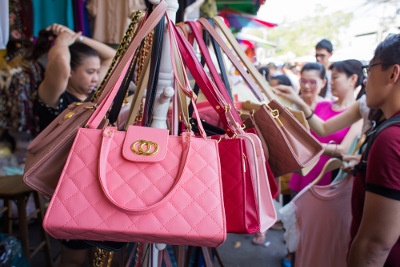Best in Manufacturing – March 11, 2018
Each Sunday, we publish a list of top articles and other content related to manufacturing in areas like quality control, product development, supply chain management, sourcing, auditing and law.
1. Whac-A-Supply Chain
This featured article makes a great analogy to supply chains and Whac-A-Mole. In supply chains, companies will sometimes try to optimize one metric (e.g., lead times, cost savings) at the expense of others. They whack one problem only for another to pop up.
 An essential question companies with supply chains need to ask is: what are we optimizing for? Are we optimizing for:
An essential question companies with supply chains need to ask is: what are we optimizing for? Are we optimizing for:
- Short lead times
- Low costs
- On-time delivery
- …or some other factor
If you try to improve these areas randomly and without direction, then you might incur additional costs that offset gains elsewhere. But by identifying what goal ranks above the others in importance, firms can realize which costs are and aren’t worthwhile. This way, they can “whac” less of their supply chain.
Another pivotal aspect of improving a supply chain is understanding landed cost, which the author defines as follows:
Landed cost is the aggregated costs of sourcing and delivering a product to the end user. This could be a retail shelf, e-commerce doorstep or manufacturing line. A landed cost calculation does not only account for the purchase price and transportation costs, but also inventory carrying costs, tariffs and a risk variance associated with stock-outs or line shutdowns, among others.
Focusing on and reducing a few miniscule costs and not considering their impact on overall supply chain objectives and landed costs could hurt your business more than help it. Learn more about improving your supply chain by reading the informative featured article in the link below:
How an Arcade Game Shows the Landed Cost Model Is Necessary to Supply Chains – Micah Mallace, Supply Chain Dive
2. A major improvement to jean manufacturing
Some stores stock jeans that are pre-faded. While I’m personally not a fan of jeans that look like they’ve gone through an industrial shredder, I’m not the entire market. The reality is that, in the jeans market, consumers prefer a variety of styles, ranging from very faded and tattered to simpler, classic styles.
But what consumers might not know is how that fading process takes place. An oxidizer called potassium permanganate is used on jeans to give them that iconic broken-in appearance.
The chemical isn’t perfect though. As the featured article mentions:
[Potassium permanganate] can irritate workers’ skin and lungs if they aren’t wearing their protective equipment, and can be harmful to aquatic life if it isn’t treated properly before being disposed.
To some, these effects might seem trivial. Yet nearly all jeans in the entire world are treated with this chemical, which greatly increases the scale of how many people and places come into contact with it.
Levi’s wants to phase this chemical completely out of its supply chain and in the process has discovered a quicker way to fade jeans using lasers. Their project to phase out the chemical is called Project FLX, which stands for “future-led execution”.
Instead of utilizing potassium permanganate and manual labor (to sandpaper jeans), the new jean fading process burns the jeans very precisely over the course of roughly 90 seconds. And each time the jeans are lasered, it’s the same—there’s no variation like with relying on humans and chemicals for fading.
I must admit: I’ve never considered all the work that goes into designing and making jeans, nor any of the processes behind their creation. To see the future of jean manufacturing and how it’s currently done, check out this interesting article in the link below:
Levi's Will Soon Rely Entirely on Lasers to Give Its Jeans That Classic Finish – Marc Bain, Quartzy
3. Using blockchain to improve manufacturing business operations
Many people associate blockchain with digital currencies like Bitcoin, Ripple and Dogecoin. The idea of exchanging monetary value typically gets the spotlight. But for manufacturers, blockchain holds great promise in additional ways.
T he author of this featured article identifies three areas where manufacturers will see value in blockchain:
he author of this featured article identifies three areas where manufacturers will see value in blockchain:
- The reinvention of process: data siloes and duplicative processes will fall one by one with blockchain in a supply chain
- Productivity and quality enhancements: there won’t be any more worries about staying in sync. Blockchain will keep everyone constantly updated at every stage of the chain. There won’t be any more “one-off data updates, exceptions and reconciliations”.
- Increased transparency: blockchain will enable real-time sharing across the supply chain and help users accurately identify what happens and when.
Let’s take a look at logistics as an example. As your goods leave a factory, each item with a barcode is scanned. This scan tells everyone in the chain where the goods are and at what time. No one can change this log in time without everyone else knowing. Once the goods reach the exit port, they’re scanned again. Finally, once the goods arrive at your warehouse, they’re scanned yet again.
Each time the goods are scanned, a “digital handshake” is recorded that offers transaction information. This insight can help companies determine how accurate and acceptable your lead or delivery times are. And this is but one example of blockchain in a supply chain.
If you’re interested in blockchain, you can check out how it makes supply chains less messy (go to #4). You can also read more about it in this white paper (go to #5). Or if you’d like, you can read this full featured article by clicking the link below:
How Blockchain Can Transform Business Operations for Manufacturers – Melanie Cutlan, Manufacturing.net
4. More expensive Chinese goods
Trade is an essential part of the global economy. Without it, we wouldn’t have many of our favorite products at affordable prices. A major component of trade is sourcing from where is most cost effective so that companies can pass savings on to customers.
But when firms source from other countries, sometimes domestic industries feel threatened or like they’re competing against stacked odds. In this situation, governments step in and aid in a variety of ways, one of them being raising trade barriers.
When it comes to international economic relationships, there is an element of worry that one country’s industry will completely dominate another country’s and in time eliminate it. Tariffs and import quotas are occasionally used as a measure to ensure this outcome never happens.
An “eye-for-an-eye” mentality pervades international trade relations. Often, if one country imposes trade restrictions, the nation affected by them will respond in kind.
This featured article examines this problem in the context of the U.S. and China. The Trump administration is considering enacting tariffs on Chinese imports. Chinese manufacturers are a large part of the global supply chain and imposing tariffs on them could result in a trade war and higher prices for everyday products.
If the Trump tariffs are enacted, China might respond with retaliatory tariffs on American products, like soybeans and integrated circuits.
Tariffs could affect everything from electronics to shoes to furniture. Until it’s announced which products and industries will be targeted, firms in America and China are left guessing if the consumers of their products will have to pay more.
Read this featured article to learn more about tariffs between the U.S. and China and the everyday products that might be affected by them. Follow the link below to read more:
Walmart, Nike Suppliers Put on Notice by China Tariff Threat – Angus Whitley and Daniela Wei, Bloomberg
5. Chinese copycatting: flattery or infringement?
It’s said that imitation is the highest form of flattery. However, if someone is blatantly copying your products and selling the nearly identical goods, would you be happy and flattered?
This featured article mentions the case of a famous Parisian fashion boutique named Colette that closed down. A few months later, a fan opened a store in Shanghai called “Colette: Forever”. The fan turned storeowner sees this not as brand infringement, but rather as a tribute and compliment to the original store.
 The case of Colette is a reflection of a problem many foreign firms operating in China have dealt with or at least feared. Imitation goods and brands can cut into revenue or, potentially even worse, ruin a company’s image.
The case of Colette is a reflection of a problem many foreign firms operating in China have dealt with or at least feared. Imitation goods and brands can cut into revenue or, potentially even worse, ruin a company’s image.
For example, a Gucci bag might sell as a “Guxxi” bag in a fake goods shopping center. Some consumers might know it’s fake and buy it anyway. But some might not realize it’s a knockoff. They might be told (and believe) that the bag is just one rejected by the factory that makes the real ones.
The buyer might have a bad experience with the fake bag and then associate that feeling with the real brand. In this case, the value of the real brand is being evaluated on the quality of a knockoff, which is undesirable and unfair.
A separate risk aside from knockoffs is rejected goods sold without permission.
Sometimes the factory that makes authentic products will have a few that aren’t completely up to par. Factory workers will sneak them out and sell them on the grey market. These products aren’t up to standard, yet they still carry the brand name. To mitigate this risk, companies rely on product destruction to ensure rejected products don’t reach consumers.
There are benefits to manufacturing in China. But there are also risks, like exposing a company to intellectual property infringement.
Are you curious about copycats in China? Check out the featured article to learn more:
China’s Luxury Copycats Say They’re Fans, Not Fakers – Yiling Pan, Jing Daily
We’re constantly scanning the web for top manufacturing stories and news. If you’d like to submit an article for consideration for our weekly Best in Manufacturing, send us a message and let us know.







